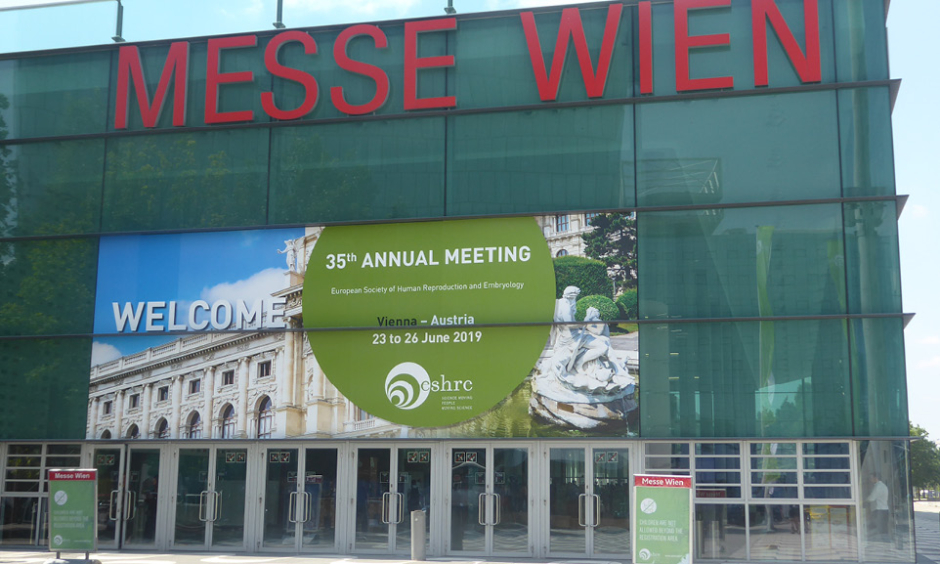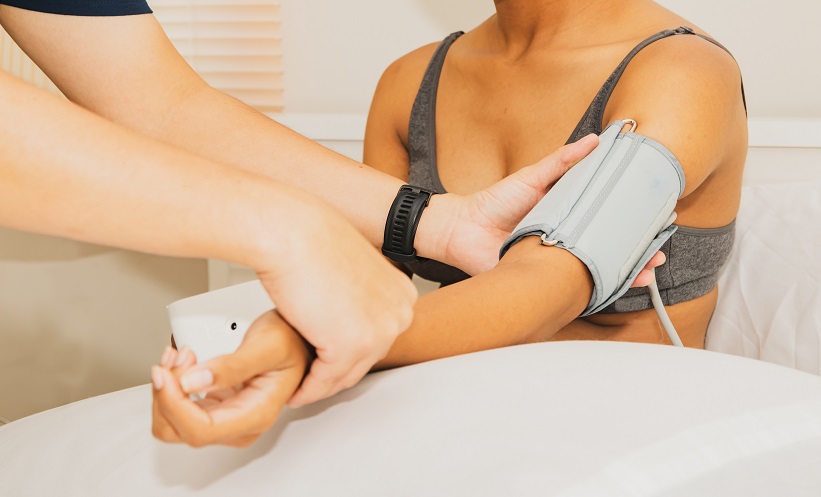Innovation and forward-thinking are not new concepts for the Austrian capital of Vienna; the city has been continuously producing a steady stream of brilliant minds for centuries. When we consider esteemed names such as Schrödinger, Asperger, Freud, and Schubert, we must also draw on them for inspiration in the disciplines that we partake. Reproductive health is increasingly vital for physical, mental, and socio-economic reasons, meaning that inspiration is more important than ever towards developing sustainable solutions that can change people’s lives for the better. As such, we are proud to present this review of the 35th ESHRE Congress held in the stunning city Vienna.
Prof R.G. Edwards and Dr J. Cohen, from the UK and France, respectively, were the first pioneers to conceive the idea for ESHRE at a meeting in Helsinki, Finland, with their colleagues from the international reproductive health community. They expressed the need, from both patients and researchers, for the formation of a society in which the values of collaborative study and sharing of ideas are instilled for the betterment of the field. In 1985, following the small beginnings of several informal meetings, it was decided that the official annual meeting was to be held in Bonn, Germany. Since this time, the society’s congresses have grown to become some of the largest gatherings of reproductive health specialists in the world.
There was no shortage of engaging stories of advancement in the field presented at this year’s event. Perhaps most ambitious was a study involving the analysis of sperm characteristics in microgravity conditions. By boldly claiming that the research community has an obligation to realistically consider the feasibility of reproduction in space, and perhaps even colonisation of other planets, a precedent was set at the congress to dream big and push the envelope. Results from the ORExPo study were shared for the first time showing the effects that environmental influences such as air pollution have on female fertility markers: an especially important study considering the increased urbanisation of human populations. Additionally, the delineation of a male biological clock in another study truly represents a paradigm shift in how reproductive success can be measured, highlighting the importance of the information we share with men considering parenthood.
As always, we have included a hand-picked selection of abstracts that caught our attention, which are penned by the authors themselves to provide first-hand summaries for your reading pleasure. A wide variety of important topics are covered, including but not limited to the influence of paternal age and ejaculatory abstinence length on intracytoplasmic sperm infection success, the identification of low β human chorionic gonadotropin concentration as an indicator of poor perinatal outcome in women, and the predictive value of the Sperm Zona-Adhesion Score for implantation outcome. These, along with the other fantastic summaries, are testament to the high calibre of work being presented at ESHRE.
Our congress review also includes a look at some of the thought-provoking sessions from ESHRE, such as ‘The pressure paradox: can egg freezing tune out the tick tock of the biological clock?’ facilitated by Dr Sarah Jarvis MBE, which looked the impact social egg freezing is having on age and pregnancy. Dr Jarvis, as our featured congress interview, gives us insight into what led her to become a general practitioner, as well as exploring the ESHRE session, highlighting the importance of educating women earlier on their fertility options and their individual fertility windows.
ESHRE 2019 was, as always, an incomparable event for those with a vested interest in reproduction and embryology. The team here at the European Medical Journal look forward to the 36th annual ESHRE meeting 2020 amongst the hustle and bustle of Copenhagen, Denmark, which is sure to be another unmissable event for the sharing of knowledge and best practice. Without further ado, we hope you enjoy our review of ESHRE 2019’s congress highlights.
Study Supports the Existence of the Male Biological Clock
THE BIOLOGICAL clock of women stops their fertility in its tracks at an average age of 51. For many years, despite known declines in sperm counts and increased sperm DNA damage, it was thought that fertility in men did not have such time restrictions. However, Dr Guy Morris, Centre for Reproductive and Genetic Health, London, UK, presented results on 26th June at ESHRE 2019 that suggested that men do indeed possess a biological clock.
The analysis from 4,833 in vitro fertilisation and intracytoplasmic sperm injection cycles performed at a single centre in London, UK, investigated patterns in age of males and outcomes of procedures. The male partners were grouped into five age groups for analysis: ≤35, 36–40, 41–44, 45–50, and >51 years of age. A male and female each aged <35 years were used as reference control groups for comparison.
Significant declines in success rates of procedures were observed as the age of the males in the groups increased: <35 = 49.9%, 36–40 = 42.5%, 41–45 = 35.2%, 46–50 = 32.8%, and >51 = 30.5%. Even when adjusted to take into account the maternal age, the probability of pregnancy still decreased significantly with paternal age >51 years. Despite this drop in success, miscarriage rate was not affected by male age in this study. Interestingly, it was noted that 80% of the cohort’s couples with male partners >51 years of age were treated with intracytoplasmic sperm injection, a treatment for male infertility.
Dr Morris concluded, “In the context of this emerging evidence for the deleterious effect of increasing paternal age, our data certainly support the importance of educating men about their fertility and the risks of delaying fatherhood.”
Study Confirms Added Obstetric Risk with Blastocyst Transfer
BLASTOCYST transfer has become a routine procedure for in vitro fertilisation and intracytoplasmic sperm injection. This increase in embryo culture time of 5 or 6 days versus 2 or 3 days in traditional culturing before implantation is associated with an increase chance of pregnancy and live birth, but results from a long cohort study, presented on 24th June at ESHRE 2019, suggested that an increased obstetric risk may be associated with this procedure.
The study analysed almost 90,000 assisted reproduction babies born in the Nordic countries: Denmark, Norway, and Sweden. Of the total study population, 69,751 were singletons and 18,154 were twins. The singleton and twin cohorts comprised 8,368 and 1,167 babies born after blastocyst transfer and 61,383 and 16,987 babies born after using traditional 3-day embryo transfer, respectively.
The risk of the baby being large for gestational age was analysed, showing that there was a 23% higher risk of this occurring in singletons born after fresh blastocyst transfer compared to 3-day embryo transfer. In everyday terms, this would present as a minor increase in incidence from 3.7% to 4.3%. Although an increased risk in the chance of a baby being preterm was seen with the use of frozen blastocyst use, no changes was seen with the use of fresh blastocyst. Interestingly, the incidence of twins occurring increased from 2.3% following the fresh 3-day transfers to 4.0% following blastocyst transfer.
Commenting of the findings, Dr Anne Laerke Spangmose, Copenhagen University Hospital, Copenhagen, Denmark, who presented the results, said “Today, blastocyst culture plays a crucial role in ART treatment. It increases survival rates of frozen-thawed embryos and so supports the use of single embryo transfer to reduce twin births. From our results, the greater use of frozen blastocyst transfer could offset the adverse effects of extended embryo culture.”
Frozen Sperm Retain Characteristics in Outer Space Conditions
COLONISATION of other planets and reproduction outside Earth might sound like far-fetched or distant ideals, however research presented on the 24th June at this year’s ESHRE meeting may have taken us a small step closer, attesting that frozen sperm samples display a distinct lack of difference in a variety of characteristics in microgravity conditions compared to those in ground conditions. Dr Montserrat Boada presented the findings from Dexeus Women’s Health, Barcelona, Spain, in collaboration with microgravity engineers from the Polytechnic University of Barcelona.
Microgravitational effects have been previously studied in the context of cardiovascular, central nervous system, and musculo-skeletal function; however, little is known about how human sperm and eggs can be influenced. This is particularly true for frozen samples: the state in which they would eventually be transported into space.
During the study, a small aerobatic training aircraft (CAP10) capable of generating short-duration hypogravity conditions conducted 20 parabolic maneuvers, allowing 8 seconds of microgravity to which 10 on-board, frozen sperm samples taken from healthy donors could have functional measurements taken. These included motility, morphology, concentration, vitality, and DNA fragmentation. The results showed 100% concordance between microgravitational and ground samples for DNA fragmentation rate and vitality, and 90% for sperm concentration and motility. Minor discrepancies could feasibly be explained by heterogeneity of the sperm samples.
“If the number of space missions increases in the coming years, and are of longer duration, it is important to the study the effects of long-term exposure to space in order to face them. It’s not unreasonable to start thinking about the possibility of reproduction beyond the Earth,” explained Boada. She added that her group next plan to validate these preliminary results and move onto using larger sperm samples, both frozen and fresh, and to induce longer periods of microgravity.
IVF and ICSI Pregnancy Rates have Peaked in Europe
PREGNANCY rates in Europe from in vitro fertilisation (IVF) and intracytoplasmic sperm injection (ICSI) have peaked. The data, presented by at ESHRE on the 25th of June in Vienna, Austria, showed that success rates are at 27.1% pregnancy per IVF treatments and 24.3% following ICSI. These figures support the recent trend of a higher success rate in IVF over ICSI. Data were also presented on other trends in assisted reproductive fertility treatments.
The data were collected by ESHRE from the European national registries from 2016. IVF, ICSI, egg donations, and intrauterine insemination treatments were monitored, covering >800,000 cycles in 2016, resulting in 165,000 babies being born. This provides not just the largest, but the most accurate view of assisted reproduction treatments in Europe. Dr de Geyter, Chair of EHSRE’s European IVF Monitoring Consortium, shared his estimate that the programme includes 84% of all assisted reproductive treatments in Europe. However, this was the first year to not include any UK data so far, which usually see around 60,000 treatments each year.
Results showed that the success rates are no longer rising as they seem to have reached a peak. Despite the success rate of IVF, European clinics favoured ICSI 2:1 over IVF, with 359,858 and 125,626 treatments, respectively. Another favoured strategy which has higher pregnancy rates is the use of blastocytes: 5-day-old rather than 3-day-old embryos.
While this highlighted a peak in the rates of success from IVF and ICSI, one treatment that is showing rising success rates and cycle numbers is frozen embryo cycles: embryos are cryopreserved to be thawed and transferred in a later cycle. The treatment saw a rise in pregnancy rate per treatment of 1.3% from 2015 to 2016, where it reached a success rate 30.5%. The data analysis showed that around half were frozen embryo transfers, which is also a higher rate than in 2015.
Paternal Smoking can Impact Male Offspring Semen Quality
SPERM quality could be affected by paternal smoking, as found in the preliminary results from the Danish National Birth Cohort study. The results, presented on the 25th June 2019 at ESHRE, showed that low sperm counts and concentrations were associated with paternal smoking, irrespective of maternal smoking.
Dr Sandra Søgaard Tøttenborg, Bispebjerg Frederiksberg Hospital, Copenhagen, Denmark, said: “Our larger study does support these previous findings that paternal smoking is associated with sperm concentrations in male offspring independently of maternal smoking. We also found the association was independent of other preconceptional and prenatal risk factors for adult semen quality – including paternal age, alcohol, caffeine consumption, pre-pregnancy BMI, and household occupational status.”
The researchers analysed 778 19-year-old men whose mothers were registered in the Danish National Birth Cohort between 1996–2002. The maternal report included paternal smoking information from gestational Week 16. The semen quality of these men was analysed using the World Health Organization (WHO) criteria. Sperm motility, concentration, morphology, and total sperm count were analysed.
The men who had fathers who smoked daily, and mothers who did not smoke, displayed a 9% lower sperm count and an 8% lower sperm concentration than the sons whose fathers were non-smokers. However, the impact was not as great as maternal smoking: “The effect of maternal smoking is much larger. If the mother but not the father smoked, the reduction was 26% for sperm concentration and 46% for sperm count. It’s certainly worse for the boys if the mother smokes. Nevertheless, the circumstances in which the father smokes but the mother doesn’t is much more prevalent, so this is still very relevant for public health,” continued Dr Tøttenborg.
The researchers recognised that the observed impact of paternal smoking on sperm count and concentration was not dramatic compared with risk factors such as exposure to specific pesticides and urogenital diseases. However, it does sit in a similar range to that of smoking in the adult man.
New Understanding of Environmental Influences on Female Fertility Marker
RESULTS from the ORExPo study were reported in a ESHRE press release dated 25th June 2019 and could be the first steps towards understanding how environmental factors influence female fertility markers. The study examined levels of anti-Müllerian hormone (AMH) and its concentration level in women who were exposed to different levels of air pollution and to assess the hypothesis that environmental factors such as air pollution and environmental chemicals could disrupt the biosynthesis, signalling, or metabolism of hormones.
The study was led by Prof Antonio La Marca, University of Modena and Reggio Emilia, Emilia-Romagna, Italy, and looked at 1,463 AMH measurements that were taken from a total of 1,318 women who were living in Modena between 2007 and 2017. It considered daily particulate matter (PM), which was defined as PM2.5 or PM10, and nitrogen dioxide (NO2). The levels of AMH were linked to the participant’s age and residential address in the database, and the analysis used environmental data and a ‘geo-localisation’ estimate based on this data. The researchers grouped results into quartiles based on the concentrations of the PM and NO2.
Results showed that even though age >25 years was inversely and significantly associated with lower serum AMH levels, the fourth quartile of results in terms of PM and NO2 levels also demonstrated much lower concentrations of serum AMH than the lower quartiles. The participants who had the lowest serum level of AMH, i.e., ‘severe ovarian reserve reduction’, had been exposed to levels of PM10, PM2.5, and NO2 of >29.5, 22, and 26 mcg/m3, respectively. This was more frequent in the fourth quartile than the first three for PM10 (62% versus 38%), PM2.5, and NO2.The European Union (EU)-recommended upper limits for these PM are 40, 25, and 40 mcg/m3, respectively.
Prof La Marca explained: “This means by our calculations […] that exposure to high levels of PM10, PM2.5, and NO2 increases the risk of having a severely reduced ovarian reserve by a factor of between 2 and 3.”
No Benefits Proven for ICSI over IVF in Non-Male Factor Cases
A LARGE, international study involving 5,000 patients from Belgium and Spain has shown that fresh and cumulative live birth rates in non-male factor cases are similar in those treated with intracytoplasmic sperm injection (ICSI) and in vitro fertilisation (IVF). The findings were presented in a press release on 26th June at the 2019 ESHRE Annual Meeting in Vienna, Austria.
Since its development in the 1990s, ICSI has quickly grown to become one of the predominate means by which infertility, particularly of male cause, has been tackled: before this time, it was near impossible for men to father children if their sperm were of poor quality or insufficient in number. Currently, the technique has expanded to include cases of female-cause infertility and as a practice outnumbers conventional IVF cycles by around two to one.
In explaining the increased trend of using ICSI for the treatment of fertility, Dr Panagiotis Drakapoulos, Centre for Reproductive Medicine (UZ Brussel), Belgium, commented that “the rationale for this seems to be that ICSI is associated with a higher likelihood of fertilisation and increased number of embryos: but this is controversial.”
No overall differences in live birth rate, fertilisation rate, and cumulative live birth rate were observed between the two approaches, similarities that were evident across four different patient response categories characterised by poor (1–3) to high (>15) egg retrieval. “It’s clear from these results that the number of oocytes retrieved has no value in the selection of the insemination procedure in cases of non-male infertility,” stated Dr Drakapoulos. The study also considered patient response to ovarian stimulation.
In debunking misconceptions around the wide-spread preference of ICSI as opposed to IVF, the group hopes to inform clinicians to not blindly recommend one technique or the other to patients blanketed under the ‘infertile’ umbrella, and that the number of viable eggs is not as determining a factor as previously thought.








